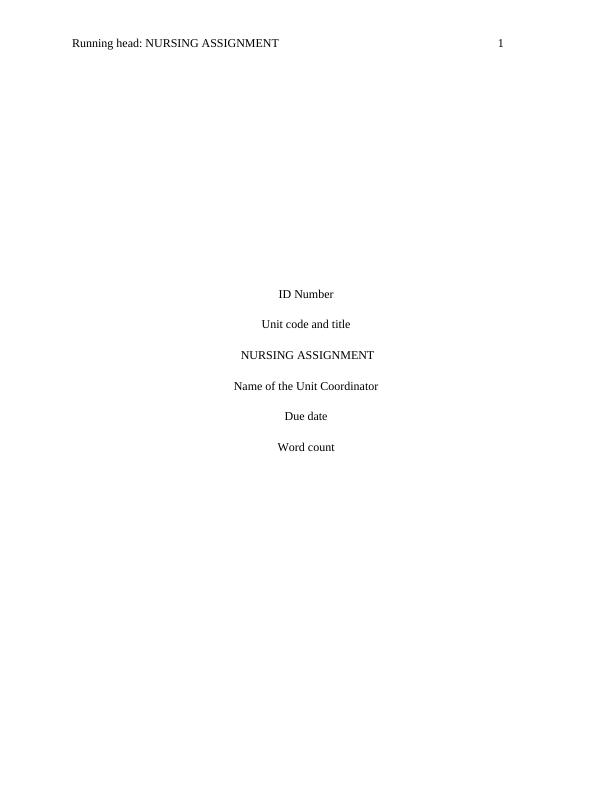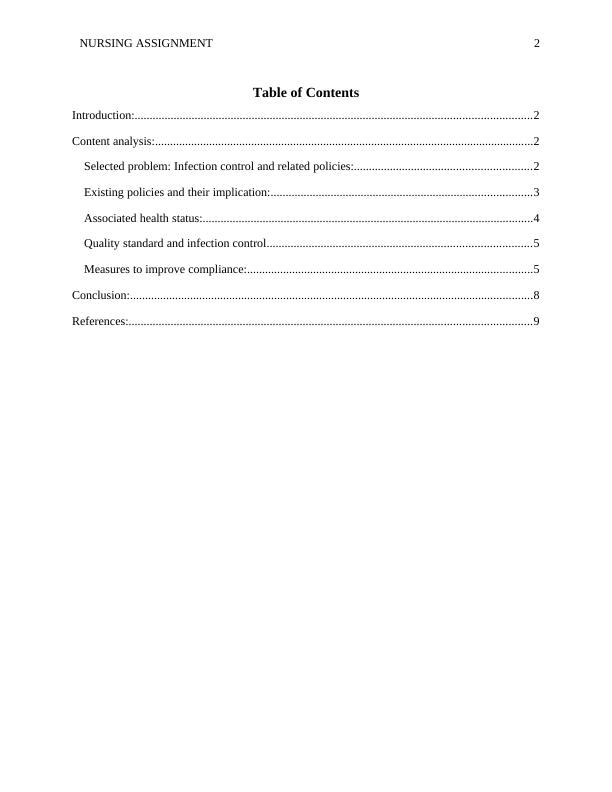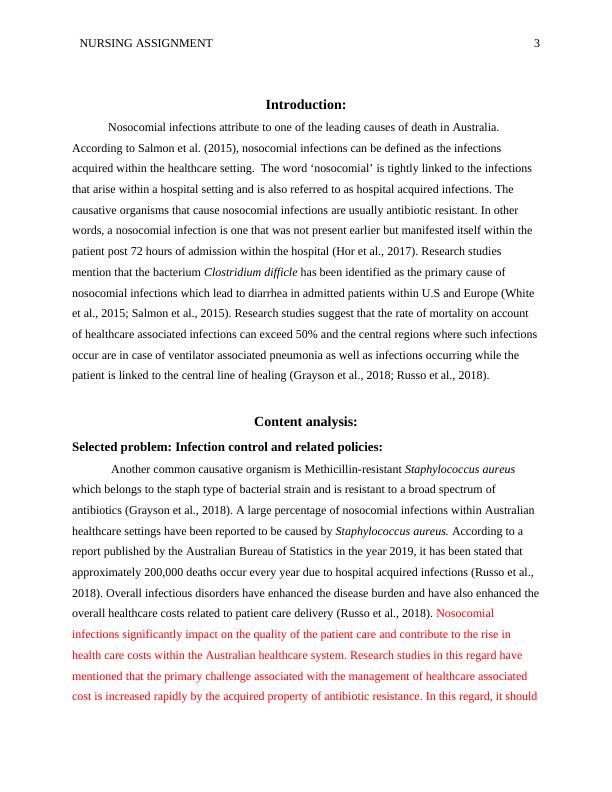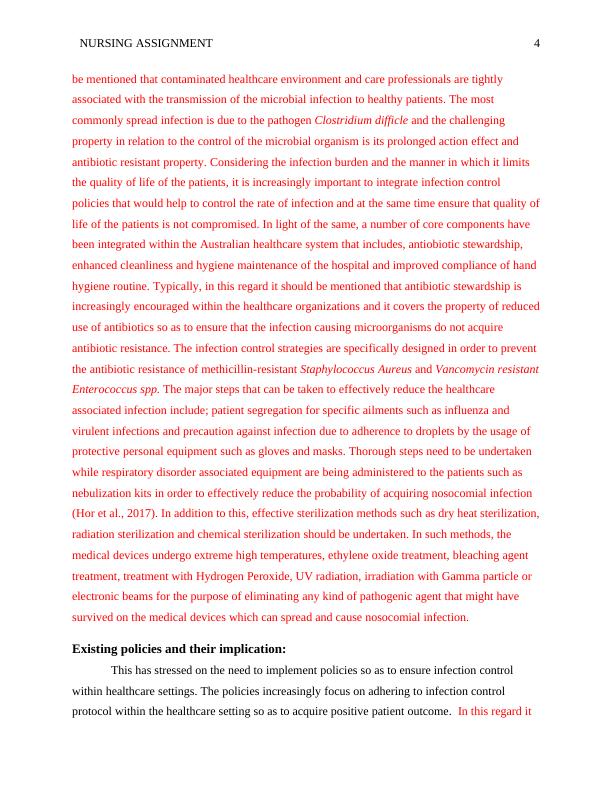Nosocomial Infections | Report
11 Pages3353 Words17 Views
Added on 2022-09-14
Nosocomial Infections | Report
Added on 2022-09-14
ShareRelated Documents
Running head: NURSING ASSIGNMENT 1
ID Number
Unit code and title
NURSING ASSIGNMENT
Name of the Unit Coordinator
Due date
Word count
ID Number
Unit code and title
NURSING ASSIGNMENT
Name of the Unit Coordinator
Due date
Word count

NURSING ASSIGNMENT 2
Table of Contents
Introduction:....................................................................................................................................2
Content analysis:..............................................................................................................................2
Selected problem: Infection control and related policies:...........................................................2
Existing policies and their implication:.......................................................................................3
Associated health status:..............................................................................................................4
Quality standard and infection control........................................................................................5
Measures to improve compliance:...............................................................................................5
Conclusion:......................................................................................................................................8
References:......................................................................................................................................9
Table of Contents
Introduction:....................................................................................................................................2
Content analysis:..............................................................................................................................2
Selected problem: Infection control and related policies:...........................................................2
Existing policies and their implication:.......................................................................................3
Associated health status:..............................................................................................................4
Quality standard and infection control........................................................................................5
Measures to improve compliance:...............................................................................................5
Conclusion:......................................................................................................................................8
References:......................................................................................................................................9

NURSING ASSIGNMENT 3
Introduction:
Nosocomial infections attribute to one of the leading causes of death in Australia.
According to Salmon et al. (2015), nosocomial infections can be defined as the infections
acquired within the healthcare setting. The word ‘nosocomial’ is tightly linked to the infections
that arise within a hospital setting and is also referred to as hospital acquired infections. The
causative organisms that cause nosocomial infections are usually antibiotic resistant. In other
words, a nosocomial infection is one that was not present earlier but manifested itself within the
patient post 72 hours of admission within the hospital (Hor et al., 2017). Research studies
mention that the bacterium Clostridium difficle has been identified as the primary cause of
nosocomial infections which lead to diarrhea in admitted patients within U.S and Europe (White
et al., 2015; Salmon et al., 2015). Research studies suggest that the rate of mortality on account
of healthcare associated infections can exceed 50% and the central regions where such infections
occur are in case of ventilator associated pneumonia as well as infections occurring while the
patient is linked to the central line of healing (Grayson et al., 2018; Russo et al., 2018).
Content analysis:
Selected problem: Infection control and related policies:
Another common causative organism is Methicillin-resistant Staphylococcus aureus
which belongs to the staph type of bacterial strain and is resistant to a broad spectrum of
antibiotics (Grayson et al., 2018). A large percentage of nosocomial infections within Australian
healthcare settings have been reported to be caused by Staphylococcus aureus. According to a
report published by the Australian Bureau of Statistics in the year 2019, it has been stated that
approximately 200,000 deaths occur every year due to hospital acquired infections (Russo et al.,
2018). Overall infectious disorders have enhanced the disease burden and have also enhanced the
overall healthcare costs related to patient care delivery (Russo et al., 2018). Nosocomial
infections significantly impact on the quality of the patient care and contribute to the rise in
health care costs within the Australian healthcare system. Research studies in this regard have
mentioned that the primary challenge associated with the management of healthcare associated
cost is increased rapidly by the acquired property of antibiotic resistance. In this regard, it should
Introduction:
Nosocomial infections attribute to one of the leading causes of death in Australia.
According to Salmon et al. (2015), nosocomial infections can be defined as the infections
acquired within the healthcare setting. The word ‘nosocomial’ is tightly linked to the infections
that arise within a hospital setting and is also referred to as hospital acquired infections. The
causative organisms that cause nosocomial infections are usually antibiotic resistant. In other
words, a nosocomial infection is one that was not present earlier but manifested itself within the
patient post 72 hours of admission within the hospital (Hor et al., 2017). Research studies
mention that the bacterium Clostridium difficle has been identified as the primary cause of
nosocomial infections which lead to diarrhea in admitted patients within U.S and Europe (White
et al., 2015; Salmon et al., 2015). Research studies suggest that the rate of mortality on account
of healthcare associated infections can exceed 50% and the central regions where such infections
occur are in case of ventilator associated pneumonia as well as infections occurring while the
patient is linked to the central line of healing (Grayson et al., 2018; Russo et al., 2018).
Content analysis:
Selected problem: Infection control and related policies:
Another common causative organism is Methicillin-resistant Staphylococcus aureus
which belongs to the staph type of bacterial strain and is resistant to a broad spectrum of
antibiotics (Grayson et al., 2018). A large percentage of nosocomial infections within Australian
healthcare settings have been reported to be caused by Staphylococcus aureus. According to a
report published by the Australian Bureau of Statistics in the year 2019, it has been stated that
approximately 200,000 deaths occur every year due to hospital acquired infections (Russo et al.,
2018). Overall infectious disorders have enhanced the disease burden and have also enhanced the
overall healthcare costs related to patient care delivery (Russo et al., 2018). Nosocomial
infections significantly impact on the quality of the patient care and contribute to the rise in
health care costs within the Australian healthcare system. Research studies in this regard have
mentioned that the primary challenge associated with the management of healthcare associated
cost is increased rapidly by the acquired property of antibiotic resistance. In this regard, it should

NURSING ASSIGNMENT 4
be mentioned that contaminated healthcare environment and care professionals are tightly
associated with the transmission of the microbial infection to healthy patients. The most
commonly spread infection is due to the pathogen Clostridium difficle and the challenging
property in relation to the control of the microbial organism is its prolonged action effect and
antibiotic resistant property. Considering the infection burden and the manner in which it limits
the quality of life of the patients, it is increasingly important to integrate infection control
policies that would help to control the rate of infection and at the same time ensure that quality of
life of the patients is not compromised. In light of the same, a number of core components have
been integrated within the Australian healthcare system that includes, antiobiotic stewardship,
enhanced cleanliness and hygiene maintenance of the hospital and improved compliance of hand
hygiene routine. Typically, in this regard it should be mentioned that antibiotic stewardship is
increasingly encouraged within the healthcare organizations and it covers the property of reduced
use of antibiotics so as to ensure that the infection causing microorganisms do not acquire
antibiotic resistance. The infection control strategies are specifically designed in order to prevent
the antibiotic resistance of methicillin-resistant Staphylococcus Aureus and Vancomycin resistant
Enterococcus spp. The major steps that can be taken to effectively reduce the healthcare
associated infection include; patient segregation for specific ailments such as influenza and
virulent infections and precaution against infection due to adherence to droplets by the usage of
protective personal equipment such as gloves and masks. Thorough steps need to be undertaken
while respiratory disorder associated equipment are being administered to the patients such as
nebulization kits in order to effectively reduce the probability of acquiring nosocomial infection
(Hor et al., 2017). In addition to this, effective sterilization methods such as dry heat sterilization,
radiation sterilization and chemical sterilization should be undertaken. In such methods, the
medical devices undergo extreme high temperatures, ethylene oxide treatment, bleaching agent
treatment, treatment with Hydrogen Peroxide, UV radiation, irradiation with Gamma particle or
electronic beams for the purpose of eliminating any kind of pathogenic agent that might have
survived on the medical devices which can spread and cause nosocomial infection.
Existing policies and their implication:
This has stressed on the need to implement policies so as to ensure infection control
within healthcare settings. The policies increasingly focus on adhering to infection control
protocol within the healthcare setting so as to acquire positive patient outcome. In this regard it
be mentioned that contaminated healthcare environment and care professionals are tightly
associated with the transmission of the microbial infection to healthy patients. The most
commonly spread infection is due to the pathogen Clostridium difficle and the challenging
property in relation to the control of the microbial organism is its prolonged action effect and
antibiotic resistant property. Considering the infection burden and the manner in which it limits
the quality of life of the patients, it is increasingly important to integrate infection control
policies that would help to control the rate of infection and at the same time ensure that quality of
life of the patients is not compromised. In light of the same, a number of core components have
been integrated within the Australian healthcare system that includes, antiobiotic stewardship,
enhanced cleanliness and hygiene maintenance of the hospital and improved compliance of hand
hygiene routine. Typically, in this regard it should be mentioned that antibiotic stewardship is
increasingly encouraged within the healthcare organizations and it covers the property of reduced
use of antibiotics so as to ensure that the infection causing microorganisms do not acquire
antibiotic resistance. The infection control strategies are specifically designed in order to prevent
the antibiotic resistance of methicillin-resistant Staphylococcus Aureus and Vancomycin resistant
Enterococcus spp. The major steps that can be taken to effectively reduce the healthcare
associated infection include; patient segregation for specific ailments such as influenza and
virulent infections and precaution against infection due to adherence to droplets by the usage of
protective personal equipment such as gloves and masks. Thorough steps need to be undertaken
while respiratory disorder associated equipment are being administered to the patients such as
nebulization kits in order to effectively reduce the probability of acquiring nosocomial infection
(Hor et al., 2017). In addition to this, effective sterilization methods such as dry heat sterilization,
radiation sterilization and chemical sterilization should be undertaken. In such methods, the
medical devices undergo extreme high temperatures, ethylene oxide treatment, bleaching agent
treatment, treatment with Hydrogen Peroxide, UV radiation, irradiation with Gamma particle or
electronic beams for the purpose of eliminating any kind of pathogenic agent that might have
survived on the medical devices which can spread and cause nosocomial infection.
Existing policies and their implication:
This has stressed on the need to implement policies so as to ensure infection control
within healthcare settings. The policies increasingly focus on adhering to infection control
protocol within the healthcare setting so as to acquire positive patient outcome. In this regard it

End of preview
Want to access all the pages? Upload your documents or become a member.
Related Documents
Controlling Transmission of Healthcare Acquired Methicillin-Resistant Staphylococcus Aureus (HA-MRSA) Infectionslg...
|12
|4091
|470
Controlling Transmission of Healthcare Acquired MRSAlg...
|8
|3492
|100
The Art and Science of Nursinglg...
|13
|3341
|26
Control of Nosocomial infections in Delhi In Indialg...
|12
|3168
|371
The Royal College of Physicians Ireland Reportlg...
|17
|4455
|46
Training and Education of Hand Hygiene among Nursing Professionals to Reduce Hospital Acquired Infectionlg...
|12
|3083
|158
